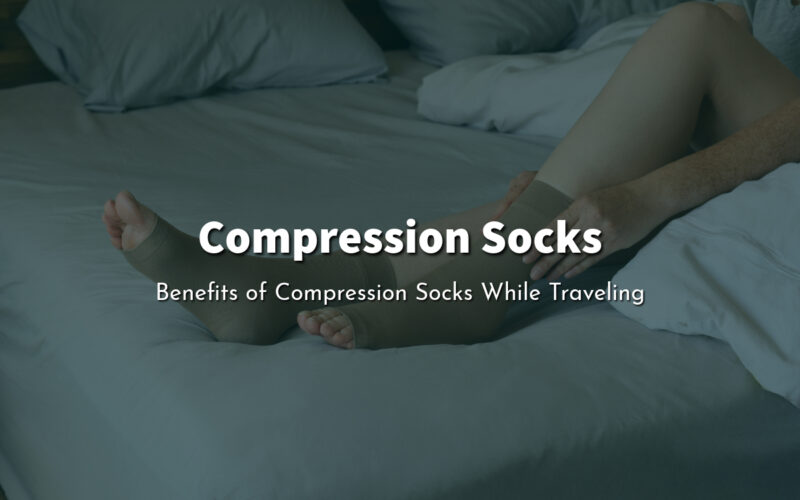How Compression Socks Can Be Helpful While Traveling

Compression socks are beneficial for long flights or extended periods of sitting because they help improve circulation and reduce the risk of swelling and deep vein thrombosis (DVT).
People Who Can Benefit from Compression Socks:
Compression socks are specially designed socks that apply gentle pressure to your legs, ankles, and feet. They are made from elastic materials that help improve blood circulation by squeezing the veins and muscles in your legs. Here’s who can benefit from wearing compression socks:
1. Travelers:
Compression socks are highly recommended for travelers, especially during long flights, car rides, or train journeys. They help prevent swelling in the legs and feet caused by prolonged sitting or immobility.
2. Pregnant Women:
Pregnancy can lead to swelling in the legs and feet due to increased pressure on blood vessels. Compression socks can help reduce swelling and discomfort during pregnancy.
3. Athletes:
Compression socks are popular among athletes because they can improve blood flow, enhance performance, and aid in recovery after intense workouts or competitions.
4. People with Varicose Veins or Spider Veins:
Compression socks can help alleviate symptoms and discomfort associated with varicose veins and spider veins by improving circulation and reducing swelling.
5. Individuals Recovering from Surgery:
After surgery, particularly procedures involving the legs or lower body, compression socks can promote healing by reducing swelling and the risk of blood clots.
6. Individuals with Edema:
Edema is swelling caused by excess fluid trapped in your body’s tissues. Compression socks can help reduce edema in the legs and ankles by improving circulation and aiding fluid drainage.
7. Those at Risk of Deep Vein Thrombosis (DVT):
DVT is a serious condition where blood clots form in deep veins, often in the legs. Compression socks can help prevent DVT by improving blood flow and reducing the likelihood of blood pooling and clot formation.
8. People Who Stand or Sit for Long Periods:
Jobs or activities that involve prolonged standing or sitting can lead to swelling and discomfort in the legs. Compression socks provide support and promote circulation, reducing fatigue and discomfort.
Benefits of Compression Socks:
- Improved Circulation: Compression socks help squeeze blood back towards the heart, preventing blood from pooling in the veins.
- Reduced Swelling: By improving circulation and aiding in fluid retention, compression socks can reduce swelling in the legs and feet.
- Prevention of Leg Fatigue: Enhanced blood flow and reduced swelling can alleviate leg fatigue and discomfort, especially during prolonged periods of activity or inactivity.
- Lower Risk of Blood Clots: Compression socks can help prevent blood clots, particularly during long flights or recovery from surgery.
How to Choose Compression Socks:
- Compression Level: Compression socks come in different levels of pressure (measured in mmHg). Mild compression (8-15 mmHg) is suitable for mild swelling and fatigue, while higher levels (15-20 mmHg, 20-30 mmHg, etc.) are recommended for more severe conditions or specific medical needs.
- Fit: Ensure the socks fit properly and comfortably without being too tight or restrictive. They should provide compression without cutting off circulation or causing discomfort.
How to use compression socks effectively:
- Choose the Right Size:
- Compression socks come in different sizes and compression levels. Ensure you choose socks that fit snugly but comfortably. They should not be too tight or restrictive.
- Put Them On Properly:
- Sit down and roll the sock down to the heel, then slip your foot into the sock.
- Gradually pull the sock up your calf, ensuring it sits smoothly and comfortably without bunching or folding.
- Benefits of Compression Socks:
- Improved Circulation: Compression socks help promote blood flow by applying gentle pressure to your legs, preventing blood from pooling in your lower extremities.
- Reduced Swelling: They can minimize swelling in the feet and ankles, which commonly occurs during long periods of sitting.
- Prevention of DVT: By improving circulation, compression socks reduce the risk of developing deep vein thrombosis, a serious condition caused by blood clots.
- Wear Throughout Your Journey:
- Wear compression socks throughout your journey, especially during long flights or car rides.
- If you’re prone to swelling or have a history of circulation issues, consider wearing compression socks even before you travel to prevent discomfort.
Explore the best compression socks for travel in 2024 by National Geographic
Read More:








